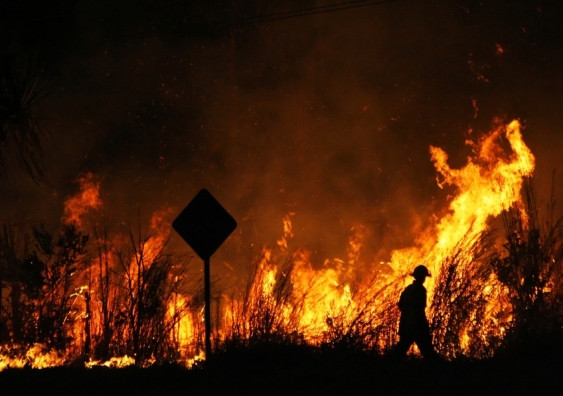Strategizing for Safety: Developing an Effective Bushfire Management Plan
Strategizing for Safety: Developing an Effective Bushfire Management Plan
Blog Article
Essential Tips for Bushfire Monitoring to Make Sure Fire Protection

Understanding Bushfire Threat Degrees
Understanding the varying degrees of bushfire risk is essential for effective preparation and prep work in mitigating possible risks to properties and lives. Bushfire threat degrees are commonly classified based on variables such as weather condition conditions, gas schedule, topography, and historical fire behavior. By comprehending these threat areas, individuals and levels can proactively apply techniques to reduce vulnerability and boost resilience when faced with potential bushfire events.
The first level of bushfire danger is reduced danger, where the possibility of a bushfire happening and creating considerable damage is very little. Risky degrees represent a substantial threat, with conditions helpful to rapid fire spread and severe fire habits.
Recognizing these bushfire risk levels enables stakeholders to tailor their preparedness and action actions as necessary, making certain a aggressive and effective method to bushfire administration.
Creating a Defensible Space
Effective bushfire administration begins with establishing a defensible area around residential or commercial properties to enhance defense versus potential fire hazards. A defensible room is a barrier zone that creates a barrier between a structure and the bordering flammable vegetation. This room works as a critical line of defense, providing firemans a risk-free location to run and helping to minimize the danger of a fire infecting the residential property.
When creating a defensible area, it is necessary to take into consideration the format of the residential property and the bordering landscape. Clearing up vegetation, specifically very flammable plants, within a particular radius of the residential or commercial property can aid stop the fast spread of fires. Furthermore, keeping a well-irrigated area around the property can further improve its defensibility.
Routine maintenance of the defensible space is crucial to ensure its efficiency. This includes cutting looming branches, getting rid of dead greenery, and maintaining the location cost-free of debris. By spending time and initiative right into establishing and preserving a defensible space, homeowner can considerably improve their opportunities of shielding their homes and assets during a bushfire.
Carrying Out Fireproof Landscape Design
When creating landscapes to reduce the risk of bushfires, incorporating fire-resistant elements is necessary for boosting home defense and lowering fire dangers. Select plants with high dampness web content, low oil web content, and minimal dead greenery to reduce the threat of fire spread.

Developing an Emergency Evacuation Strategy
Developing a detailed emergency emptying strategy is essential for ensuring the safety and security and wellness of people throughout potential bushfire incidents (BMP). An effective evacuation strategy should outline clear treatments to adhere to in case of a bushfire threat, including assigned emptying routes, setting up factors, and communication procedures
To begin creating an emergency situation emptying strategy, it is necessary to analyze the certain threats and vulnerabilities of your place. Recognize numerous discharge paths that result in risk-free locations far from the fire, thinking about variables such as surface, road accessibility, and potential risks. Develop communication channels to alert homeowners of an impending evacuation, utilizing techniques such as sirens, text notifies, or door-to-door notices.
Routinely testimonial and practice the discharge plan with all residents or community members to make sure every person recognizes their functions and duties. Conduct drills to examine the effectiveness of the plan and make any type of required modifications. By having a well-prepared evacuation plan in area, you can enhance the chances of a risk-free and orderly emptying during a bushfire emergency situation.
Keeping Fire Security Equipment
After establishing a detailed emergency situation see page emptying prepare for bushfire incidents, it is crucial to focus on the normal maintenance of fire security equipment to guarantee optimal performance and readiness. Regular maintenance of fire safety tools such as fire extinguishers, smoke detectors, smoke alarm, and automatic sprinkler is critical in safeguarding lives and residential or commercial property during a bushfire. When required., performing routine assessments, screening, and maintenance of these devices by qualified specialists is essential to guarantee they are in functioning order.
Fire extinguishers ought to be inspected regularly for pressure levels, visible damage, and proper functionality. By carefully maintaining fire safety tools, people can improve their preparedness and response abilities in the event of a bushfire.
Conclusion
In final thought, efficient bushfire administration includes comprehending danger degrees, producing defensible areas, implementing fireproof landscaping, creating emptying plans, and maintaining fire safety equipment. By complying with these vital pointers, individuals can make certain much better fire security and security for their properties and areas. It is essential to focus on positive measures to alleviate the dangers connected with bushfires and to be planned for emergency situations.
By comprehending the subtleties of bushfire threat levels, developing defensible spaces, carrying out fire-resistant landscape design, developing thorough evacuation strategies, and making certain the upkeep of fire safety and security equipment, people and areas can dramatically boost their strength versus the ravages of wildfires - BMP. These suggestions are not only vital for safeguarding versus prompt fire dangers but likewise for cultivating long-term fire security approaches that can make a substantial difference in the face of intensifying bushfire hazards
High-risk levels signify a substantial hazard, with problems conducive to fast fire spread and severe fire behavior. Normal maintenance of fire safety tools such as fire extinguishers, smoke detectors, fire alarms, and sprinkler systems is critical in guarding lives and property throughout a bushfire.In verdict, effective bushfire management includes comprehending threat degrees, developing defensible spaces, executing fire-resistant landscape design, creating emptying strategies, and preserving fire safety and security devices.
Report this page